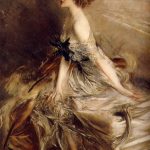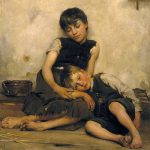Giovanni Giacometti, born on March 7, 1868, in Stampa, Switzerland, was a Swiss painter and father of renowned sculptors Alberto and Diego Giacometti. Though often overshadowed by the fame of his sons, Giovanni played a significant role in the Swiss art scene, contributing to the development of modern art in the early 20th century.
Giovanni Giacometti’s artistic journey began with his enrollment at the Munich Academy of Fine Arts in the late 1880s. Under the influence of the Symbolist movement, he developed an interest in expressive and emotive art. This early exposure to Symbolism would shape Giovanni’s approach to painting, emphasizing the subjective and symbolic aspects of art.
In 1902, Giovanni married Annetta Stampa, and the couple went on to have four children, including the celebrated sculptors Alberto and Diego Giacometti. The Giacometti family home in the small Swiss village of Stampa became a hub of artistic activity, fostering a creative environment that influenced all of Giovanni’s children.
Giovanni Giacometti was a leading figure in the Swiss modernist movement known as Cercle Carré, a group of artists seeking to break away from academic traditions and embrace new, avant-garde styles. Giovanni’s works from this period, such as “The Red Balloon” (1913), demonstrate his shift towards more modern and abstract forms, influenced by movements like Fauvism and Cubism.
The artist’s landscapes, often depicting the scenic Engadin Valley, showcased his unique interpretation of nature. His style evolved to capture the essence of the Swiss landscape with a blend of naturalism and abstraction. Giovanni’s paintings, marked by expressive brushstrokes and a vibrant color palette, reflected his deep connection to the Swiss Alps and the changing seasons.
While Giovanni Giacometti embraced modernist elements, he retained a strong attachment to traditional subjects. His portraiture work, including depictions of family members, reflects a balance between traditional techniques and the evolving language of modern art.
Giovanni’s influence extended beyond his own works to the guidance and encouragement he provided to his children. Alberto Giacometti, in particular, would go on to achieve international acclaim for his sculptural works, but the familial connection to the artistic heritage of Giovanni remained evident.
The Swiss art scene recognized Giovanni Giacometti’s contributions, and he participated in numerous exhibitions throughout his career. Despite facing financial challenges, he remained dedicated to his artistic pursuits and continued to paint until his death.
Giovanni Giacometti passed away on June 25, 1933, in Glion, Switzerland. While he may not be as widely known as his famous sons, Giovanni’s legacy lies in his role as a pioneering modernist in Swiss art, influencing the trajectory of the Giacometti family’s artistic journey and contributing to the broader narrative of 20th-century European art.




